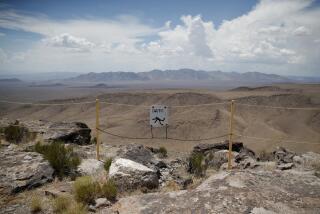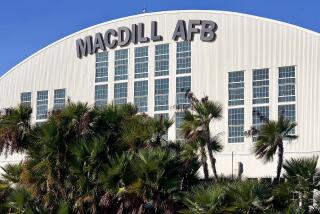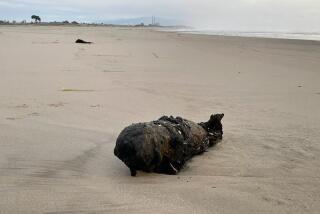Plan to Abandon Bombs Draws Outrage : Base closures: A federal commission recommended relocating the test site, now in Indiana, to Arizona. But neighbors say a safety hazard will be left behind.
- Share via
MADISON, Ind. — Scattered across miles of land north of the Ohio River lie the fruits of 50 years of war preparation: 1.4 million rounds of unexploded ammunition.
Nobody had paid much attention to the bombs, shells and mines that have piled up at the Army’s Jefferson Proving Ground since tests began there in 1941.
Now that there are plans to move testing operations to Yuma, Ariz., by 1995 and leave the bombs behind, outrage is building.
“It doesn’t make any sense economically, environmentally or morally,” said Mayor Morris Wooden. He dismissed the move, approved by Congress, as “stupid.”
The proving ground was marked for closure with 85 other military bases by the congressionally appointed Commission on Base Realignment and Closure. The panel of retired military personnel and former lawmakers was told to find ways to save money.
In the case of the proving ground, the panel decided $6.6 million a year could be saved by closing the test range, eliminating its 380 local jobs and consolidating its operations with those of the Yuma Proving Ground in Arizona.
Under the law, the commission’s decisions had to be accepted or rejected by Congress as a package, with no bases considered individually.
The commission also was ordered not to consider cleanup costs, and so far Congress has made no plans to remove any unexploded ammunition from the test range. If the bombs remain, the 100-square-mile site will have to be abandoned, officials say.
“The land’s basically lost forever and no good to anybody. And it’s a horrible safety hazard,” said Mike Moore, leader of a group of civilian employees trying to keep the test range open.
Studies by federal, state and Army officials estimate cleaning up the site would cost from $500 million to $3 billion. That would cover only a surface sweep that would make the area 45 miles northeast of Louisville, Ky., suitable only for grazing or wildlife.
“It’s safe to say the technology does not exist to clean it on a scale that would make it free for unrestricted use,” said proving ground spokesman Gary Stegner.
Without taking cleanup costs into effect, the congressional commission estimated the cost of closing the proving ground could be recouped in six years through the annual $6.6 million in savings.
But Congress’ General Accounting Office said that with cleanup costs included it could take more than 200 years for taxpayers to realize a savings.
“Closure of JPG (Jefferson Proving Ground) will cost the American taxpayer millions of dollars, damage our country’s conventional readiness, and leave an environmental wasteland in an already economically depressed area of Indiana,” said Sen. Dan Coats (R-Ind.).
But Coats and other Indiana lawmakers say there is little chance of getting Congress to take any base off the closure list.
Reconsidering one base would be certain to bring demands for reconsideration from the congressional districts where the other bases are situated.
At the urging of Indiana lawmakers, the Army is considering keeping the proving ground as a government-owned, contractor-operated testing site.
It is also possible the base could be sold to a contractor who would continue to use it as a testing ground.
Officials say if those options aren’t successful, the only solution is to abandon the property.
“The issue isn’t the jobs or the economy,” Wooden said. “The issue is, it makes no sense at all.”
More to Read
Sign up for Essential California
The most important California stories and recommendations in your inbox every morning.
You may occasionally receive promotional content from the Los Angeles Times.









